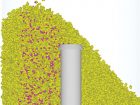
Features
Agronomy
Harvesting
Intercropping after harvest
Intercropping is gaining interest in Saskatchewan and other parts of the Prairies as producers look for strategies to reduce risks and input costs, strive to increase yields and over the long-term improve soil productivity and sustainability.
September 3, 2018 By Donna Fleury
Lana Shaw, research manager at the South East Research Farm (SERF) in Redvers, Sask., and colleagues at the Indian Head Research Farm, along with some successful early adopters, are leading the way for larger-scale conventional intercropping. Shaw estimates 2017 intercropping acreage to be between 45,000 and 50,000 acres (includes 34,000 acres of SCIC contracted acres) and is projecting upwards to 100,000 acres for 2018.
Based on the growing interest, two intercropping workshops were held in Saskatchewan last winter, attracting about 350 producers. Along with numerous presentations on agronomy, intercrop mixtures and other important considerations, Joy Agnew, project manager, agricultural research services with PAMI in Humboldt, Sask., was asked to address the important issue of separation and storage of intercrops after harvest, including existing separation technologies, potential storage issues and possible tools for storage management.
“Although we have not done any research specific to intercrops to date, nor do we have any hands on experience, we agreed to help growers and researchers find the best information we could,” Agnew explains. “To prepare for the presentations, we talked to some of the experienced intercrop growers and researchers in Saskatchewan and conducted online research. This research combined with our expertise and experience with crop handling, separation and storage of conventional monocrops, combined with some computer modelling and other tools, we have provided some suggestions to consider. However, there remains more questions than answers, and more research and experience is needed.”
One of the biggest hurdles for growers when they consider an intercrop is how to separate the two crops at or after harvest. Without the right equipment or other options for accessing equipment, growers may find intercropping an even bigger challenge. “In talking to some of the early adopters, one of the key strategies is to start small until you learn what works and what doesn’t work,” Agnew says. “Commercially available cleaning systems such as gravity tables, rotary or air separators or others work very well at a smaller scale with two crops with different seed sizes. However, its important to be reminded that existing equipment was designed for cleaning seed and removing dockage, not specifically for mixed crop separation.”
Agnew adds when considering equipment, recognize some equipment and technologies will work better than others, some will have more flexibility and a range of settings to accommodate different seed sizes and crop combinations, but others do not. “Experience is a tremendous asset and seed separation may be as much an art as a science.”
There are many factors at play for optimizing intercrop separation and storage, including the difference in seed size, shape and density. The ratio of seed sizes in the intercrop will also impact the settings for separation. For example, a higher ratio of large seed to small seed may be easier to separate. The level of dockage and material other than grain (MOG) will affect the efficiency of seed separation. The difference in seed maturity at harvest will also need to be considered, not only at harvest but also at the crop mixture selection and seeding stage.
“One outcome of discussions at the workshops is a smaller manufacturer of seed-cleaning technology has indicated they are planning to develop a seed separation technology specifically for intercrop separation,” notes Agnew. “The company is working on a prototype with early adopters to trial and pilot this new technology. However, until this new technology or other options become available, growers will have to continue to modify and use existing equipment.”
Timing of crop separation and whether it should be done at harvest or after harvest is also a big question. Although separation at harvest is probably ideal, it is also a very busy time and not always practical. “We suspect that if intercrops are stored together for a short time, in most cases that will be fine,” Agnew says. “One of the key factors is to understand the drying conditions of each of the individual crops in the intercropping mix. We ran some equilibrium moisture content (EMC) computer scenarios for some of the crops, and unless there is a huge difference in the moisture content, short-term storage should be okay. However, the larger the differences in moisture content the bigger the potential problem.” For example, the Canadian Grain Commission suggests the target moisture content of oilseeds like canola and flax is 10 per cent, while peas is 16 per cent and lentils is 13.5 per cent.
PAMI also looked at aeration and natural air drying considerations, which raised more questions about air flow rate, airflow resistance, uniformity of crop mixtures and other factors. Agnew says that they looked at various combinations of intercrops and with all of the comparisons the ideal harvest temperature should be between 15 and 20 C. “If the intercrops are coming off hotter than that, then they should be cooled just like other crops. We aren’t sure how long moisture migration or spoilage will take in storage with the mixtures. Based on EMC, a pea and canola mixture if both crops are dry should be okay. However, flax and lentil combinations have a big difference in EMC at constant temperature and humidity. A mixture of dry flax and tough lentils may minimize the potential for moisture migration, however the tough lentils are still at risk of spoilage. Regular monitoring and moisture management is important.”
Another consideration is particle size segregation in the bin. Depending on the differences in seed size and proportion of each crop in the mixture, layers and areas of concentration may result in poor uniformity of air flow. There may also be localized areas of increased resistance or pockets of one grain type with a considerably different relative humidity, which may cause issues. For producers who want to try and manage intercrops by blowing air using aeration or natural air drying, the target and achievable airflow rates remain unknown for mixed crops. Canola has a very high airflow resistance, while peas is really low, so the actual airflow rate for that mixture would likely be somewhere in the middle. Producers should also be aware that most bin monitoring sensors that measure moisture content will not work with intercrops or mixed crops since they are calibrated for a single crop. The sensors calculate moisture content based on moisture and humidity for a single crop. Temperature on the other hand may be a good indicator of an issue and will work as designed in stored intercrops.
Until the number of acres and producers increases, funding remains difficult to access for key research problems. However, PAMI recently received funding from the Saskatchewan Pulse Growers to do a comprehensive literature review. “In this current study, a review of available information on intercropping for conventional agriculture with a focus on equipment settings and modifications needed for intercropping is underway,” Agnew explains. “The goal is to compile all available information from literature and early adopters in one place for other producers to access. We want to talk to the early adopters and anyone with experience with intercropping to gather as much information as possible, so please connect with us.”
[Editor’s note: You can contact Joy Agnew at jagnew@pami.ca]. The project wraps up in April 2019 and the information will be available to producers in summer 2019.
Producers can also learn more about the projects and results to date of research led by Shaw and other researchers and early adopters. This year Shaw has several trials in place. Facing funding challenges, Shaw successfully funded a chickpea-flax trial (21 treatments and 84 plots) with crowd funding through Twitter and word of mouth. Visit www.southeastresearchfarm.org for more updates.


